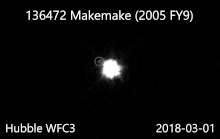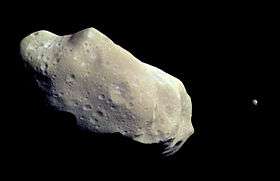S/2015 (136472) 1
S/2015 (136472) 1, nicknamed MK2 by the discovery team,[2] is the only known moon of the dwarf planet Makemake.[1][4][5] It is estimated to be 175 km (110 mi) in diameter (for an assumed albedo of 4%) and has a semi-major axis at least 21,000 km (13,000 mi) from Makemake.[1][6] Its orbital period is ≥ 12 days (the minimum values are those for a circular orbit; the actual orbital eccentricity is unknown).[7][1][5] Observations leading to its discovery occurred in April 2015, using the Hubble Space Telescope's Wide Field Camera 3, and its discovery was announced on 26 April 2016.[2]
.jpg) Makemake and its moon (arrow) | |
| Discovery[1] | |
|---|---|
| Discovered by |
|
| Discovery date | April 2015 |
| Designations | |
Designation | Makemake I |
| MK2 (unofficial)[2] | |
| Orbital characteristics[1] | |
| >21000 km | |
| Eccentricity | unknown |
| >12.4 days | |
| Satellite of | Makemake |
| Physical characteristics | |
Mean radius | ~ 87.5 km (for an assumed albedo of 4%)[1] |
| Albedo | ~ 0.1 0.04[1] |
| 25.0[3] | |
| 7.8[lower-alpha 1] | |
Makemake and Sedna are the least-well-known of the large trans-Neptunian objects. The discovery of MK2 and follow-up observations in 2018 will enable Makemake's mass to be determined, which will allow an estimate of its density and other characteristics.
Observations

A preliminary examination of the discovery imagery suggests that MK2 has a reflectivity similar to charcoal, making it an extremely dark object. This is somewhat surprising because Makemake is the second-brightest-known object in the Kuiper belt. One hypothesis to explain this is that its gravity is not strong enough to prevent bright but volatile ices from being lost to space when it is heated by the distant Sun.[8]
Alex Parker, the leader of the team that performed the analysis of the discovery images at the Southwest Research Institute, said that from the discovery images, MK2's orbit appears to be aligned edge-on to Earth-based observatories. This would make it difficult to detect because it would be lost in Makemake's glare much of the time, which, along with its dark surface, would contribute to previous surveys failing to observe it.[8] However, follow-up images from 2018 appear to show it circling the primary. These observations may be enough to determine whether the orbit is close to circular, which would suggest that MK2 was formed by an ancient impact event, or if it is significantly elliptical, which would suggest that it was captured.[8]
Name
The nickname 'MK2' simply means object 2 in the Makemake system. A permanent name may be chosen from an associated figure in the mythology of Easter Island, such as Makemake's companion Haua, or one of Makemake's offspring: Tive, Rorai, Hova and Arangi-kote-kote.
Notes
- Absolute magnitude difference between the satellite and Makemake[3]
References
- Parker, A. H.; Buie, M. W.; Grundy, W. M.; Noll, K. S. (2016-04-25). "Discovery of a Makemakean Moon". The Astrophysical Journal. 825 (1): L9. arXiv:1604.07461. Bibcode:2016ApJ...825L...9P. doi:10.3847/2041-8205/825/1/L9.
- "HubbleSite – NewsCenter – Hubble Discovers Moon Orbiting the Dwarf Planet Makemake (04/26/2016) – The Full Story". hubblesite.org. Retrieved 26 April 2016.
- William M. Grundy (13 February 2020). "Makemake (136472 2005 FY9)". Lowell Observatory. Retrieved 20 February 2020.
- Chang, Kenneth (26 April 2016). "Makemake, the Moonless Dwarf Planet, Has a Moon, After All". The New York Times. Retrieved 26 April 2016.
- Parker, A. (2016-05-02). "A Moon for Makemake". Planetary Society blogs. Planetary Society. Retrieved 2016-05-02.
- "Hubble Spies A Moon Orbiting A Distant Dwarf Planet". Popular Science. Retrieved 26 April 2016.
- "Hubble discovers moon orbiting the dwarf planet Makemake". EurekAlert!. 26 April 2016. Retrieved 26 April 2016.
- Mike Wall (26 April 2016). "Distant Dwarf Planet Makemake Has Its Own Moon". Space.com. Retrieved 26 April 2016.

